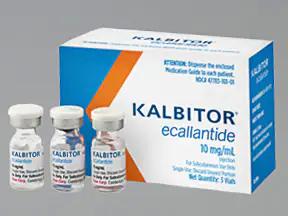Kalbitor Dosage
Generic name: Ecallantide 10mg in 1mL
Dosage form: injection, solution
Drug class: Hereditary angioedema agents
Medically reviewed by Drugs.com. Last updated on Jul 1, 2025.
Recommended Dosing
The recommended dose of KALBITOR is 30 mg (3 mL), administered subcutaneously in three 10 mg (1 mL) injections. If the attack persists, an additional dose of 30 mg may be administered within a 24 hour period.
Administration Instructions
KALBITOR should only be administered by a healthcare professional with appropriate medical support to manage anaphylaxis and hereditary angioedema.
KALBITOR should be refrigerated and protected from the light. KALBITOR is a clear, colorless liquid; visually inspect each vial for particulate matter and discoloration prior to administration. If there is particulate matter or discoloration, the vial should not be used.
Using aseptic technique, withdraw 1 mL (10 mg) of KALBITOR from the vial using a large bore needle. Change the needle on the syringe to a needle suitable for subcutaneous injection. The recommended needle size is 27 gauge. Inject KALBITOR into the skin of the abdomen, thigh, or upper arm. Repeat the procedure for each of the 3 vials comprising the KALBITOR dose. The injection site for each of the injections may be in the same or in different anatomic locations (abdomen, thigh, upper arm). There is no need for site rotation. Injection sites should be separated by at least 2 inches (5 cm) and away from the anatomical site of attack.
The same instructions apply to an additional dose administered within 24 hours. Different injection sites or the same anatomical location (as used for the first administration) may be used.
Frequently asked questions
More about Kalbitor (ecallantide)
- Compare alternatives
- Pricing & coupons
- Reviews (2)
- Drug images
- Side effects
- Patient tips
- During pregnancy
- FDA approval history
- Drug class: hereditary angioedema agents
- Breastfeeding
- En español
Patient resources
Professional resources
Related treatment guides
See also:
Further information
Always consult your healthcare provider to ensure the information displayed on this page applies to your personal circumstances.


